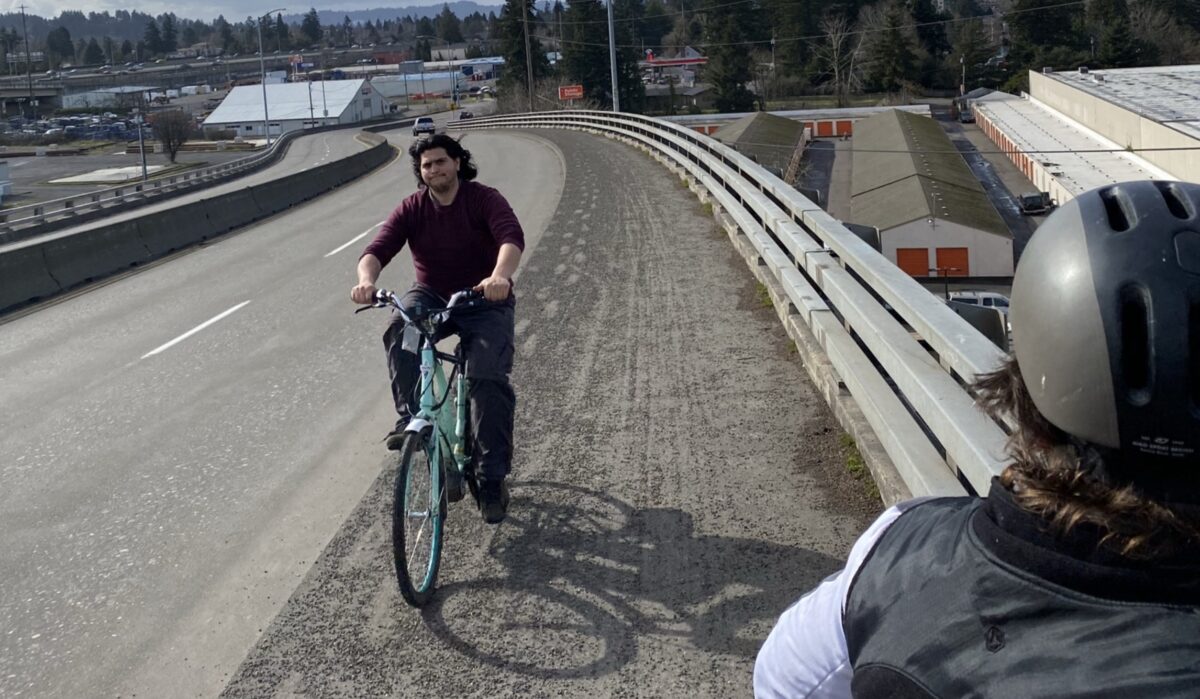
(Photo: Jonathan Maus/BikePortland)
It’s been 17 days since Portland experienced a major winter storm. For people who get around mostly by car, the storm was a relatively minor inconvenience. It was a few days of snow and ice and a bit of shoveling before things were back to normal.
But it’s a much different story for people who aren’t in a car.
For people who use bike lanes or shoulders on a bike, scooter, skateboard, roller-blades, or any type of wheeled mobility device, it’s been over two weeks since roads were free of hazardous debris. And let’s not forget that before the snow-then-slush-then-gravel, we had piles of leaves in fall, standing water after it rained, and the year-round presence of work zones and illegal parking and driving.
Taken separately, these hazards are often dismissed as minor inconveniences or yet another example of “those whiny entitled cyclists”. Together, they help explain why cycling is in decline in Portland. To be clear: These hazards make some people give up on active transportation altogether and get back in their cars.
Advertisement
For those who still choose to ride and roll, these dirty streets force them to accept yet another risk.
Portlander Julie Garner is an example of what happens when we don’t clean up this gravel quickly enough. Yesterday she was biking on SE Hawthorne at 12th when she crashed. It was severe enough that Garner received a concussion, cracked her helmet and doesn’t recall the incident. She posted to Twitter from her hospital bed that, “I was told I slipped on gravel (in bike lane).”
The day before Garner’s crash, we posted a video from the Northeast Halsey/I-205 overpass (below). Conditions there are bad even without gravel because bicycle riders and walkers in both directions are forced to share one standard sidewalk. With gravel, it’s extremely dangerous — especially as you start rolling downhill just feet away from people in cars.
Responses to both of these posts reveal widespread fear and frustration about the amount of gravel that still remains on key Portland bikeways. We’ve heard about dangerous conditions on streets like SW Terwilliger, bike lanes near Moda Center, N Interstate, Hawthorne Bridge viaduct, and so on. The problem has gotten worse with protected bike lanes where the presence of curbs and/or wants prevents plows and sweepers from getting all the way to the curb.
Advertisement
Portlander Leslie Carlson said she rode on Terwilliger from Chart House to Sheridan over the weekend: “The gravel was thick in the bike lane. We were forced to descend on to the road, which angered drivers behind us. I’m afraid somebody is gonna get really injured up there.”
Stay in the bike lane or shoulder and risk slips, falls, and flat tires; leave the bike lane and risk aggressive drivers.
(Photo: David Stein)
(Photo: Hami Rahmani)
What’s even more frustrating is that the Portland Bureau of Transportation has been aware of the problem for many years, yet it doesn’t feel like their response has gotten any better. Their crews were quick to lay down about 425 cubic yards of gravel to help people drive more safely; but the consequences of that move last for weeks and result in less safety for others.
“We understand that gravel in the roadway isn’t pleasant — many of us are people who bike too — and that is why we work as quickly as possible to pick it up.”
— John Brady, PBOT
Our coverage of the gravel-in-the-bike-lanes problem dates back to 2007. There are now 18 posts (including this one) in our “gravel in bike lanes” story archives. Each time we cover this issue, the response is the same: Just be patient. We’re doing our best.
PBOT says gravel recovery is “challenging because the City’s limited number of sweepers travel 2-3 mph and have 518 miles of streets to cover.” In response to concerns raised this weekend, PBOT encouraged people to report it via PDXReporter.org or create a maintenance ticket via 503-823-1700 or pdxroads@portlandoregon.gov.
Asked today whether or not they have a specific plan to keep key bikeways clean, and why the gravel continues to be a problem after all these years, PBOT spokesman John Brady said, “We understand that gravel in the roadway isn’t pleasant — many of us are people who bike too — and that is why we work as quickly as possible to pick it up.” “This year even as we were still plowing and treating the roads, we were already looking ahead and planning how we would work to get the gravel out of the bike lanes and the shoulders. Such planning is a central part of our approach to every winter weather event.”
In response to Garner’s post, Sarah Iannarone shared via Twitter that she feels the city’s response is “very unstrategic.” “The gravel ultimately causes more problems than it solves.”
Planning is nice. Action is better. We’ve been told for years to be patient and that PBOT is doing their best. Now we’re doing our best to remain patient.
— Jonathan Maus: (503) 706-8804, @jonathan_maus on Twitter and jonathan@bikeportland.org
— Get our headlines delivered to your inbox.
— Support this independent community media outlet with a one-time contribution or monthly subscription.

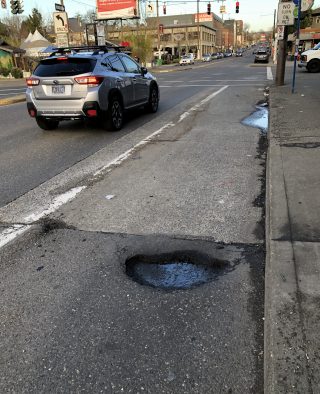




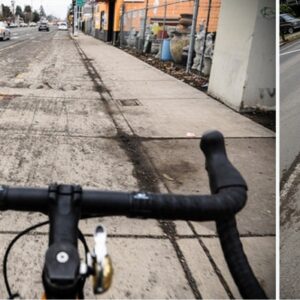
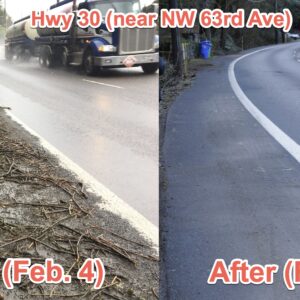
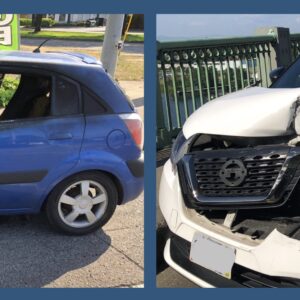
Thanks for reading.
BikePortland has served this community with independent community journalism since 2005. We rely on subscriptions from readers like you to survive. Your financial support is vital in keeping this valuable resource alive and well.
Please subscribe today to strengthen and expand our work.
in 2010, after another major storm, i hit a patch of gravel & slammed down on. my shoulder. thought i had dislocated it, but had broken it. PBOT finally swept that path after i called. they just don’t give a damn. it should be #1 on their post-meltoff list. thanks for calling this out.
Trash, snow and gravel in the bike lanes is a poignant representation of the strengths and perceived weaknesses of biking. Gravel can’t be left on the street because a windshield might be chipped and drivers will complain, it can’t be swept onto the sidewalk (usually), so “let’s pile it in the bike lane.” Bike riders can be flexible and either take on the dangerous conditions, drive or walk. Similarly, biking, in general, exists in this middle space where it can be ignored or trashed depending on the mood or time of day.
Biking is both too fast and too slow. It is easy or it is so hard it takes years of practice to do well. It is cheap and accessible or it is only for wealthy elites. It is good for people who can’t drive or it is only for the able-bodied and athletic. It is for friendly inclusive people or it is a special club full of mean people that yell at everyone. Bike infrastructure is too expensive but not expensive enough for DOTs to be interested. It is an equalizer across socioeconomic groups or it only furthers the desires of old white males. Bike infra increases revenue for businesses or it kills them. It energizes wannabe progressive politicians, but they can’t be initiated into a career of public service until they murder a bike lane. It builds community or it divides us all. It energizes a grass roots base or it sucks all of the oxygen out of the room and we should stop talking about it. Bike use is increasing on it’s own and doesn’t need prioritization or it is decreasing and should be abandoned by cities as a mode of transport. Bike riding is an environmentally sustainable transportation mode, but somehow causes cars to idle, which increases pollution. It is safer than driving, but it is so dangerous that we need public campaigns to constantly remind people to ride safely. Bike riders are invisible, but they are everywhere and always in my way. The bike lobby is all powerful and too loud, if only they advocated enough for themselves, city hall would be able to help them.
Also, biking is adaptable enough to be squeezed into existing infrastructure without resources because bike riders can be car drivers, bike riders and pedestrians all at the same time. So, if a person wants a safe place to bike they should file a complaint every time something needs to be fixed, and they should stop complaining all the time, because it’s not all about them.
Comment of the decade?!
As the article points out this is a serious problem for people who get around on skateboards. On Saturday I went down NE33rd and was forced to ride the white line most of the way due to all of the garbage in the bike lane.
https://www.youtube.com/watch?v=ewoP00QpeOs
Do you mean NE 33rd Drive?
Gravel is garbage and basically it is third world level stuff. Mag chloride is the bees knees but Portland won’t every use it because the fishies. However, they will dump poo in the river and allow the homeless/house less/ whatever they are this week to poo out in the open too. Maybe they can use poo as apart of their recycling plan to clear streets?
My car is 20 years old and still has corrosion free fasteners on its drivetrain and suspension components, and in case you haven’t noticed fishing is something of a business in this state. Take your salt and smoke it.
As for sewage; combined sewer overflows used to occur an average of 50 times a year, but a wastewater project completed a few years ago has reduced that to four times per rainy season and once every three years during the dry season.
The road salts they use these days still rusts anything that is not stainless steel or aluminum on the bike, including the chain, cassettes and bearings, and it even tarnishes brass spoke nipples. At least sand and gravel can be washed away.
PBOT says they used a fair bit of magnesium chloride in a newsletter they sent out recently.
Sounds like salty newsletter…
Thanks for posting. I just contacted PBOT asking them to break out their sweet small format Dutch street sweeper and use it on the bike lanes.
You can contact PBOT too. Remember be nice in your request. As my Mom always said…”You catch more flies with honey than with vinegar” 🙂
Telephone: 503-823-1700 or
PDXroads@portlandoregon.gov
I dunno, Kristine – I’m kinda ready to throw around some vinegar. As JM rightly points out, every time we have a major snow event, it’s EXACTLY THE SAME, year after year after year. PBOT has many trucks that can spread gravel quickly, but almost no equipment to sweep it up. Why? – because putting down the gravel is good for cars but picking it up doesn’t affect the cars. The cars rule. I wish they would just say it.
Welcome to another fine example of PBOT spokesperson John Brady’s paternalist gaslighting. “We understand that gravel in the roadway isn’t pleasant.” Mr Brady again goes out of his way to frame cycling concerns this way, as if physical injury is just some trivial unpleasantness as long as it happens to folks on bikes. How dare anyone complain about unpleasantness when there is serious stuff going on, he is suggesting. Imagine a world where PBOT could dismiss complaints about slower traffic on a bike-laned Hawthorne with “We understand driving slower is unpleasant. Some of us actually drive too.” At least as a spokesperson, he leaves no uncertainty about what his organization believes.
This is an example of why we need commissioners, department heads, risk management personnel and cops who are actually cyclists.
Is there a map somewhere where you can see which bike lanes have been cleaned? I don’t imagine PBOT has created one but even just a list of streets would be better than nothing.
Sorry, JKE – PBOT has nothing like this. I’ve asked for it. All you’d need to do is put a GPS device on every sweeper and do a Google Maps integration (download the data to Google Maps after each shift) and you’d have a superb and useful map. But apparently it’s just not a priority for PBOT since cars and trucks can get around just fine.
If ran around the clock: 518 miles / 2 mph / 24 hours per day = 10.7 days
It’s been at least 10 days since the snow melted so that’s not really a valid excuse
And that assumes they only have the one sweeper, which is true for the protected bike lanes but not for unprotected lanes and shoulders that are still covered in gravel.
There should not be any bike lanes with gravel still on them at this point in the cleanup.
I love your comment. I never would have thought to do the math, but once I saw it, it seems such an obvious thing to have done.
PBOT gave those numbers to shut up complainers, yet the numbers prove exactly the opposite of what they intended. Your “not really a valid excuse” is an understatement. Even two sweepers (they did say they had “sweeperS”) means they could have cleared all but protected lanes in one week.
And as the article says, this has been a problem for years. Why not have six sweepers (maybe they do?) and more than one for protected lanes, so they could clear everywhere in a few days?
Did I mention I love your comment?
I did the math in my head too, and then I realized there’s more than one sweeper. So with two it’s 5.35 days, three it’s 3.5 days… or all three work in 8 hour shifts and it’s 10.7 days and it’s DONE ALREADY! What’s the hold up PBOT?! At least hit the main bike routes and then go from there.
To take the other great responses a step further…
– There are also private sweeper companies that regularly clean parking lots, etc. That would be in addition to city-owned sweepers.
– The Governor regularly declares ‘state of emergency’ for these types of events.
– ‘State of emergency’ typically allows for suspension standard drawn out procurement practices, allowing for quick response by agencies, including direct contracting with private businesses as needed. Those expenses are often reimbursable from the funds opened up by the declaration of ‘state of emergency’.
– If not there could/ should be a municipal pool contract for ongoing as-needed sweeper services.
– Mapping and GIS software already have all city bicycle lanes mapped, which can easily be prioritized during non-emergency times.
– Many if not all municipal vehicles now contain GPS tracking to assist with operations and response management, particularly during ‘states of emergency’.
– There is even software out there that will assist with service route finding for efficiency purposes.
Now that would be strategic.
If it was just that simple. Many operations that run 24 hrs. use 4 crews (4 12 hour days on at a time). So each sweeper would have to have 4 qualified operators. Your math doesn’t take into account time to empty the bin after it fills up. Don’t forget coffee and lunch breaks, time to drive to and from the shop. Some have suggested using private company’s to expedite the job. I am sure the Union might have objections to this.
Good points about the complexity, Jim. You reminded me that last Thurs I was cycling in the Ash Creek neighborhood in SW Portland when a sweeper passed me going in the opposite direction. I tried to read the name of the company on the door but it was a bit hard to see – maybe “Green Streets”? It was obviously not a city-owned sweeper. I can’t find the company in the directory of the venerable North American Power Sweeping Association (https://www.powersweeping.org/sweeping-companies/oregon/portland/).
The sweeper was going a wonderful job of cleaning the hilly residential streets of the Ash Creek neighborhood, but there are no bike lanes in this neighborhood. So who prioritizes and pays for the sweeping of these streets? Does the neighborhood association do it? Does some resident with deep pockets and a philanthropic bent arrange it? Was it a rogue operator doing good – like a Superman of Street Sweeping??
In any case, street cleaning in Portland is a big mess.
On the other hand, he did the math based on the City having only one sweeper. So your points are correct, but it doesn’t change the fact that a small number of sweepers could do the whole city in a few days.
Another way of thinking about it–PBOT did manage to acquire enough equipment and crews to spread all that gravel in just a couple days, during a snowstorm. So expecting it to remove it in several days isn’t asking too much at all. They’ve had literally decades to figure it out.
While riding on Rosa Parks. All I could think is I wish I had a leaf blower. So I could blow the gravel back into the street.
I see you posted a picture of a pothole in the middle of a bike lane. 🙁 PBOT actually fixes potholes very quickly. (They take months to respond to a sidewalk that is dangerous to pedestrians but nothing stops then from fixing the asphalt lickety split). Sorry I’m done with the editorial comment….I am grateful they fix the potholes.
Anyway, I try to report potholes on Greenway streets or if I see one in a bike lane. You can use your smartphone by going to PDXreporter.org and it’s pretty easy.
FROM PBOT:
Report a pothole:
To report a pothole, call our maintenance hotline at 503-823-1700, email pdxroads@portlandoregon.gov or access PDXReporter.
PS Julie I hope you recover quickly!
Sidewalk repair in the City of Portland is the responsibility of the property owners. So when its reported the City will eventually inspect it and send a notice to the property owners to repair it which “takes months”. If aproperty owner is proactive repairing it own their own when they see something themselves before being notified they are required to spend extra money for a voluntary repair permit not required if otherwise notified.
Sorry, Jerome, but that’s not my experience at all. I live way out in SW Portland and I’ve waited months to get a simple pothole filled – even in hot summer weather when there should be no obstacles (like weather) to impede work. Or a crew shows up and says, Sorry – this street isn’t the city’s responsibility. Or there’s just silence and the pothole gets larger and larger.
“Sidewalk repair in the City of Portland is the responsibility of the property owners” is an ancient myth typically spread by PBOT and neighborhood activists in inner Portland, but even by BDS and BPS staff. The city has long repaired broken sidewalks then put a lien on the property to pay for it by the next home buyer. On certain arterial roadways in East Portland and SW the city has a program to repair and build new sidewalks as funding becomes available, usually from state and federal grants, but also city gas tax funds. There are also Local Improvement Districts (LIDs) where property owners agree to tax themselves to pay for repairs and new sidewalks.
The city stopped repairing potholes in 2012 as part of budget cuts. It’s only when a pot hole is in danger of becoming a sink-hole that they will repair it. They do regularly inspect and map them though.
Portland doesn’t feel very Platinum when riding around after a snow storm. The city should focus more on clean up and less on creating the mess in the first place. A special irony is having our primo buffered bike facilities being the most challenging to clean in the aftermath.
Scholls Ferry Road in Washington County between SW Hall and SW Roy Rogers Road and beyond was just as bad yesterday. The bicyclists enjoying the springtime weather were taking the lane or riding in the protected striping because the bike lane was so bad. Blame ODOT for that one (state highway 210)
That road is not maintained by ODOT, despite the highway number. It’s maintained by WashCo. A similar situation to MLK in Portland, where it has a highway number but is not maintained by the State.
***portion of comment deleted by moderator***
This is the wrong place for my current complaint, because it’s about a failure of an institution other then PBOT. I went up to Kaiser Interstate today, crossed the Failing pedestrian bridge, and headed towards the little bike ramp into the maze of parking lots. Barricades. Barricades against piles of snow. They had cleared all of their lots, and dumped the snow along the northern edge of the campus parking lots, including that NE corner. I rode to my appointment on a muddy path created by the poor slobs who preceded me. They were probably better mountain bikers than I’ll ever be.
Kaiser is pretty proud of their sponsorship of Sunday Parkways, but they show little understanding of what someone biking for transportation needs. Poor mostly wave racks, very few under cover, bad spacing, and there are always bikes in them. Anyone want to try to educate them?
Mh,
Give Kaiser a phone call. The maintenance folks probably didn’t even think about it. “Squeaky wheel gets the grease”.
Jerome, just think of all the motorists who NEVER have to call to get snow removed. “They don’t even have to think about it.”
A lot of big businesses (including my own) contracted out this snow clearing work. The contractors don’t care, and it seems like it’s a bit of a sellers market since these snow events are so rare. Our contractors damaged many curbs and even lifted a concrete parking stop bar up and left it sticking out of a snow bank at a 45* angle, right next to a sidewalk.
You should blame Kaiser for that.
Ya know where’s a great place to ride in a bike lane that is 70-80% clear of gravel? Lake Oswego! Yesterday I rode Country Club Rd to Kerr Pkwy, and a sweeper had made a valiant effort to clear the bike lane and even the tiny curb lane on Kerr Pkwy. It wasn’t perfect – still a lot of gravel remaining, but it felt a lot safer.
LO certainly has other problems related to excessive motoring, but you have to give them credit for sweeping the bike lanes. Also LO hasn’t built any fancy separated lanes, so they are easy to sweep.
Related topic: Has anyone else noticed how many fallen trees are still impeding bike lanes everywhere? Contractors or city workers or whoever have cut trees just to the white line that separates the car lane from the bike lane, and left it that way. Why couldn’t they have cut off about six more feet?? Oh – I think I know: it’s not a problem unless it’s a problem for cars.
YES, glad you mentioned. I ride Terwilliger and the contractors cut trees to open sidewalks and those same trees had debris fields, large obstructions, in the bike lane only. they made cuts, just would not make cuts to open bike lane. Into the lane of travel go I. at night. such a poor choice. thanks.
dp
I agree that Portland (and its suburban jurisdictions) are excessively reliant on gravel for traction during and after snow and ice events. It’s astonishing to me that they do this.
However, that doesn’t mean they shouldn’t deploy traction aids, but that they are using the wrong one. Well-screened sand works just as effectively for cars as gravel does, is more effective in helping cyclists’ traction on snow and ice because it spreads out more evenly and is less likely to catch our tires – and has the added bonus of not getting flung up and cracking motorists’ windshields. Using gravel is just stupid.
It’s March, which means the Portland metro is mostly out of the woods for wintry events, though some places may still get occasional frost over the next few weeks, and it is indeed time for PBOT (and the counties) to start cleaning the stuff up.
I just rode up Thurman over the Balch Gulch Bridge this past weekend and the outside shoulder where I normally bike uphill was completely full of gravel. So I rode in the travel lane slowly uphill, hoping the entire time a car wouldn’t come up behind me. Thankfully no cars arrived, but it was a bit nerve-wracking. Thanks for bringing up this issue and highlighting it!
That said, this should help boost sales of gravel bikes at least…;-)
SW Jefferson, especially the downhill portion to the Goose Hollow MAX stop remains a dangerous gravel situation. I reported it on PDX reporter yesterday.
At least I have a gravel bike.
The sidewalk on the NE Halsey / 205 flyover is sketchy in normal times. See you out there Jonathan!
City PBOT should not be allowed to dump anything on the road unless they have a clear action plan to pick it up. A clear action plan should have to be passed through an external auditor, with follow-up milestones and KPIs to ensure the action plan is moving on target – with penalties and accountability if failure results. They should have to justify dumping gravel all over the city with a written plan as to how and how fast (and to what level of completion) they will correct it after the 48-hour snow event has moved on.
So like the “Bottle Bill” for gravel…if they have the funds (and priority) to lay it down then they would get their “deposit” if they picked it up….to use for next year’s gravel purchase.
Ah, they re-use it, the gravel swept up goes back in the pile along with any glass that might have been present. It’s another reason to avoid gravel because the quota of glass increases year by year. My gravel flat this year was a little shard of obsidian, I took that one out of circulation.
It really helps to report all gravelly lanes and multiuse paths on PDX Reporter.
They get cleaned up pretty quickly when reported, in my experience.
I’ve also been turning in tagged bicycle wayfinding signs, which also get cleaned up.
If there are advocates for better bikeway care internally at PBOT, they will have a much easier time getting resources allocated for routine cleanup after snow events if there is an avalanche of legitimate complaints reported. Surely, at some point, it would become easier for them to simply send crews to sweep every mile of lane that is routinely reported after a storm, rather than have crews zigzag all over the city sweeping them piecemeal.
Squeaky wheel gets the grease. Use the PDXReporter app!
Ted Buehler
Yes, very pragmatic approach – complaint driven process seems to be the only method that still sometimes works at COP. But, doesn’t PBOT actually know where they dumped the gravel, so they shouldn’t need anyone to inform them where it is? Why should this gravel location be a mystery to them?
When you call the 503-823-1700 number the person you speak to identifies themself as the repair dispatcher. They spoke of a second-shift sweeping crew. I called in the gravel patch in the bike lane on Weidler at the I-5 overpass, no idea if it’s been swept yet.
PS – Julie, I hope you are mending. I have also hit the enormous bump in the pavement (showing in the photo) – right there in the bike lane, although I just grazed it. This pavement bulge is enough to make anyone crash – could have been the gravel that caused you to spill, but that big pavement bulge is a problem for the last few years. Pavement bulge is the result of the soft asphalt bulging in the summer sun when the TriMet bus repeatedly stops/stands front tire on this spot – causing a divot and a bulge from the bus. You can see these in a few other spots, also, but this one next to the burgerville is especially dangerous due to location – hard to see it and in a busy area so you hope to not be staring at the ground as you cycle – bulge is right in the bike lane.
I called 503-823-1700 and talked to a real live person about gravel in the bike lane on SW 1st, S of Market. It only took a minute. I’ll probably make a couple more calls on the way home.
Julie, I hope you heal without incident, that was a bad crash.